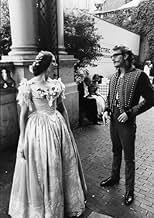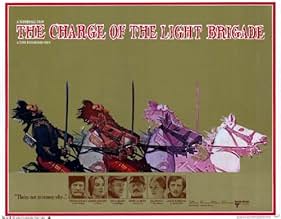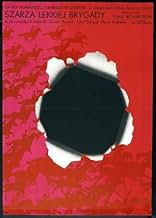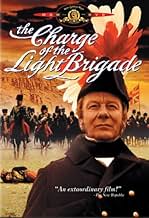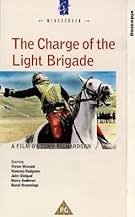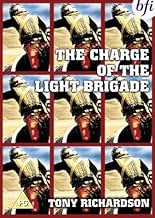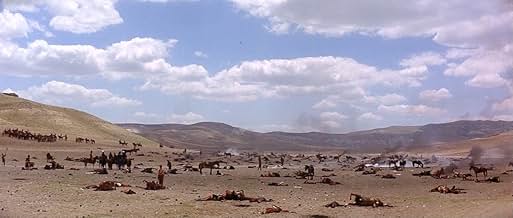VALUTAZIONE IMDb
6,6/10
4154
LA TUA VALUTAZIONE
Aggiungi una trama nella tua linguaIn 1854, during the Crimean War, poor planning leads to the British Light Brigade openly charging a Russian artillery position with tragic consequences.In 1854, during the Crimean War, poor planning leads to the British Light Brigade openly charging a Russian artillery position with tragic consequences.In 1854, during the Crimean War, poor planning leads to the British Light Brigade openly charging a Russian artillery position with tragic consequences.
- Regia
- Sceneggiatura
- Star
- Nominato ai 7 BAFTA Award
- 7 candidature totali
John J. Carney
- Trooper Mitchell
- (as John Carney)
Howard Marion-Crawford
- Lt. Gen. Sir George Brown
- (as Howard Marion Crawford)
Christopher Cunningham
- Farrier
- (as Chris Cunningham)
Recensioni in evidenza
First, it should be noted that Tony Richardson's "The Charge of the Light Brigade (1968) is not a remake of the Errol Flynn classic adventure film of 1936; rather it is based on the Cecil Woodham-Smith work of military history, "The Reason Why". Both book and film are a debunking of the Tennyson poem. And hard as it is to believe, Richardson's film actually tones down the absurdities of the three principle figures responsible for the debacle at Balaclava. And these three stooges thoroughly deserve the censure of history, for never were the lives of six hundred brave men thrown away more senselessly than with the charge of the Light Brigade.
Richardson depicts the insanity of the Crimean War and Victorian society's glorification of militarism with a death's head sense of humor which makes the horrors of the conflict all the more potent. And he is unsparing in his condemnation of the culture that could glorify so unmitigated a disaster as Balaclava. The film was made at the height of America's involvement in the Vietnam War and it is an implicit critique of that conflict and war in general in that all countries regardless of time and place indulge in the pastime of National Lying. The greater the calamity, the greater the need to lie or glorify, for always the dead must count for something. In that sense the film is universal as well as timeless.
Using animation in the style of the Victorian newspaper caricaturists, during the opening credits, the film quickly details the events that led up to the war. This is also one of the few films to hold the media, in this case the English newspapers of the time, accountable for their actions. Instead of calling for deliberations and a halt to the madness that must inevitably lead to war, the press is shown whipping the British nation into war frenzy. These animated sequences which appear throughout the film to forward the exposition are both wonderfully inventive and wickedly delicious.
Throughout the film which is satiric and misanthropic in tone, the lower classes are shown to be stupid, ugly, and easily led, while the upper classes are shown to be stupid, beautiful, and utterly incapable of leading. Indeed the only decent individuals portrayed are either destroyed or trampled under foot by events and/or the arrogant stupidity of their superiors. Yet Richardson is never judgmental; rather he takes a Kubrickian detached point of view, allowing the viewers to observe the era and its foibles/morals and judge for themselves. And England of the mid-nineteenth century is beautifully recreated here. Hairstyles and uniforms and sets are rendered in exquisite detail. It takes its rightful place along side "Barry Lyndon" and "The Duelists" as among the most successful period recreations.
The film also uses a lot of period colloquialisms such as, "My cherry-bums!" and "All this swish-n-tits has made me randified!" and "You tell that stew-stick of a brother-in-law, that Brudenell to fetch off!" Wonderful, though some first time viewers may have difficulty understanding exactly what has just been expressed. And what a cast! Trevor Howard, Harry Andrews and especially John Gielgud give career topping performances. Gielgud as Lord Raglan, the slightly befuddled commander-in-chief, steals every scene he is in. Aging, tired in mind and body, missing one arm, continuously mistaking the French, ("Our allies, My Lord...") for the enemy, never quite grasping the situation whether in his office or on the field of battle, ("England is pretty, babies are pretty, some table linen is very pretty!") Its a delightful comic turn. And who wouldn't feel sorry for anyone unfortunate enough to be caught between Trevor Howard as the choleric Lord Cardigan, ("The melancholy truth was that his golden head had nothing in it.") and Harry Andrews as the equally bilious Lord Lucan? From the moment we see his saturnine countenance striding up the marble steps of the War Office we know this is a humorless, flint-hearted martinet. Both Lords had a long running personal feud which they quickly placed on an official level as well with unfortunate consequences for the Light Brigade.
David Hemmings and Vanessa Redgrave are the young romantic leads. Hemmings is Captain Lewis Nolan, a forward thinking career officer with very definite ideas how war should be conducted. He has returned to England after service in India to join Cardigan's regiment, and quickly runs afoul of the Lord in the affair of the "Black Bottle". In reality it involved another officer, who Cardigan placed under arrest for serving porter, (it was actually Moselle) when he had given strict orders that only champagne be served at the mess. Nolan the professional is unstinting in his criticisms or the three amateur Lords conduct of the war, and yet he too will play an unwitting part in the final destruction of the Brigade. A man of honor, whose honor however does not prelude having an affair with his best friends wife. Redgrave as the wife is as always, luminescent. The supporting cast sparkles as well. Mark Dignam as General Airey, Raglan's Chief of Staff, ("Speak up Nolan, he's a bit hard of hearing, and that statue doesn't help!") Howard Marion-Crawford as Lt. General Sir George Brown, Peter Bowles as Captain Henry Duberly, Norman Rossington as Sergeant Major Corbett, ("Right foot, straw foot!") and especially Jill Bennett as a lascivious Fanny Duberly all are very effective. This was also one of the last appearances of the great English classical actor, Sir Donald Wolfit, who would die later that year.
Finally enough cannot be said of Charles Wood's wonderful screenplay. With its exquisite use of the period vernacular it does a superb job of combining characters while paring history down to the essential to reconstruct the chain of events that led up to the destruction of the Light Brigade.
Richardson depicts the insanity of the Crimean War and Victorian society's glorification of militarism with a death's head sense of humor which makes the horrors of the conflict all the more potent. And he is unsparing in his condemnation of the culture that could glorify so unmitigated a disaster as Balaclava. The film was made at the height of America's involvement in the Vietnam War and it is an implicit critique of that conflict and war in general in that all countries regardless of time and place indulge in the pastime of National Lying. The greater the calamity, the greater the need to lie or glorify, for always the dead must count for something. In that sense the film is universal as well as timeless.
Using animation in the style of the Victorian newspaper caricaturists, during the opening credits, the film quickly details the events that led up to the war. This is also one of the few films to hold the media, in this case the English newspapers of the time, accountable for their actions. Instead of calling for deliberations and a halt to the madness that must inevitably lead to war, the press is shown whipping the British nation into war frenzy. These animated sequences which appear throughout the film to forward the exposition are both wonderfully inventive and wickedly delicious.
Throughout the film which is satiric and misanthropic in tone, the lower classes are shown to be stupid, ugly, and easily led, while the upper classes are shown to be stupid, beautiful, and utterly incapable of leading. Indeed the only decent individuals portrayed are either destroyed or trampled under foot by events and/or the arrogant stupidity of their superiors. Yet Richardson is never judgmental; rather he takes a Kubrickian detached point of view, allowing the viewers to observe the era and its foibles/morals and judge for themselves. And England of the mid-nineteenth century is beautifully recreated here. Hairstyles and uniforms and sets are rendered in exquisite detail. It takes its rightful place along side "Barry Lyndon" and "The Duelists" as among the most successful period recreations.
The film also uses a lot of period colloquialisms such as, "My cherry-bums!" and "All this swish-n-tits has made me randified!" and "You tell that stew-stick of a brother-in-law, that Brudenell to fetch off!" Wonderful, though some first time viewers may have difficulty understanding exactly what has just been expressed. And what a cast! Trevor Howard, Harry Andrews and especially John Gielgud give career topping performances. Gielgud as Lord Raglan, the slightly befuddled commander-in-chief, steals every scene he is in. Aging, tired in mind and body, missing one arm, continuously mistaking the French, ("Our allies, My Lord...") for the enemy, never quite grasping the situation whether in his office or on the field of battle, ("England is pretty, babies are pretty, some table linen is very pretty!") Its a delightful comic turn. And who wouldn't feel sorry for anyone unfortunate enough to be caught between Trevor Howard as the choleric Lord Cardigan, ("The melancholy truth was that his golden head had nothing in it.") and Harry Andrews as the equally bilious Lord Lucan? From the moment we see his saturnine countenance striding up the marble steps of the War Office we know this is a humorless, flint-hearted martinet. Both Lords had a long running personal feud which they quickly placed on an official level as well with unfortunate consequences for the Light Brigade.
David Hemmings and Vanessa Redgrave are the young romantic leads. Hemmings is Captain Lewis Nolan, a forward thinking career officer with very definite ideas how war should be conducted. He has returned to England after service in India to join Cardigan's regiment, and quickly runs afoul of the Lord in the affair of the "Black Bottle". In reality it involved another officer, who Cardigan placed under arrest for serving porter, (it was actually Moselle) when he had given strict orders that only champagne be served at the mess. Nolan the professional is unstinting in his criticisms or the three amateur Lords conduct of the war, and yet he too will play an unwitting part in the final destruction of the Brigade. A man of honor, whose honor however does not prelude having an affair with his best friends wife. Redgrave as the wife is as always, luminescent. The supporting cast sparkles as well. Mark Dignam as General Airey, Raglan's Chief of Staff, ("Speak up Nolan, he's a bit hard of hearing, and that statue doesn't help!") Howard Marion-Crawford as Lt. General Sir George Brown, Peter Bowles as Captain Henry Duberly, Norman Rossington as Sergeant Major Corbett, ("Right foot, straw foot!") and especially Jill Bennett as a lascivious Fanny Duberly all are very effective. This was also one of the last appearances of the great English classical actor, Sir Donald Wolfit, who would die later that year.
Finally enough cannot be said of Charles Wood's wonderful screenplay. With its exquisite use of the period vernacular it does a superb job of combining characters while paring history down to the essential to reconstruct the chain of events that led up to the destruction of the Light Brigade.
This movie was made in 1968 but I never got the impression from watching it that it was anti war. The movie was made entirely with British actors and a British director and the Brits never had an antiwar movement (because their government gave up its militarism after Suez in 1955). The movie depicts the British army as it existed in 1850. This was a period when one gained advancement in the army by money or title. It was a largely decadent and unprofessional army and the movie I think characterizes it rather well. In fact, Nolan wrote a book complaining about the need to professionalize the army but it took the near disastrous Crimean War to affect any serious changes (it too the British Navy another generation or more to make similar changes). At the time, there was a debate about the effectiveness of cavalry with some believing that no defensive position could withstand the full force of a disciplined cavalry charge--a left over from the Napoleonic Wars--while others thought a charge into artillery was near suicidal. Nolan's roll in the battle remains controversial and whether he delivered inaccurate verbal orders to Acrdigan to charge to prove the effectiveness of cavalry even against artillery or warn the brigade away has not been established because Nolan was killed.
As for the Crimean War, it also depicts the drum beat to war accurately and the implication that most of the dying was done by commoners and much of the death was caused by disease. It was an ugly war. What isn't shown is that the condition of the Russian army was far worse. The poor Russian peasant soldiers were sent to fight with smoothbore Napeolonic Era muskets with an effective range of perhaps 100 meters while the British and the French was new rifled muskets with a range of over 300 meters. In some battles very small forces of British held off huge numbers of Russians killing hundreds.
The Battle of Balaclave is generally depicted accurately. It was a calamity of errors. Capt Nolan actually lost his head during the charge and witnesses indicate that his horse continued running with corpse in the saddle for some distance before the body collapsed. The charge was initiated by the heavy Brigade led by Lord Lucan. There was a rivalry between Lucan and Lord Cardigan (brothers in law) and both brigades initially made the charge but the Heavies did not enter the Valley of Death. The Light Brigade continued into the Valley and were decimated but not wiped out. In fact they were supported by the French cavalry the Chasseurs d'Afrique and the Russian positions were in fact overrun. I think the charge as depicted in this movie is one of the most exciting I have ever seen captured in the cinema.
The so called Valley of Death has changed considerably since the 1850s. By 1994, it was entirely planted in vineyards and the only way to gain some sense of the battle is to find the famous Tractir Bridge over the Tchernaya River and follow the lines of hills. As for the town of Balaclava...I have a photograph of the town in 1854 with the British fleet anchored in the harbor. I took a photograph of this village in 1994 from just about the same angle as the 1854 image and then compared the two. The place is completely unchanged with even the stone buildings remaining. Of course, the village today is the base of the Ukranian Black Sea fleet and there is a not so secret submarine base cared into the limestone cliffs inside the harbor.
We may think that the Crimean War is ancient history but the people of Crimea do not. They have sort of a living museum called the Panaorma. This is a museum devoted to the siege of Sevastopol. There is a circular path and the visitor is engulfed by the on going battles on both sides of the path. One may wander the hills above Sevastopol and many of the rifle pits and trenches from the war remain (they were reused by the Russians during the unsuccessful defense of the city in 1942). It is a wonderful museum and it exemplifies the Russian attitude that history is alive and they don't forget their past.
This is a historically accurate movie. It moves a little slow at times and it has some amusing cartoonish graphics (almost reminiscent of Monty Python graphics). All the major players obviously have a great deal of fun with their rolls.
Anecdotes: Tony Richardson's two children, Nastasha and Joely are in the film as well is his sister in law Vanessa Redgrave. I think I have these relationships correct. Anyway, they are all related.
As for the Crimean War, it also depicts the drum beat to war accurately and the implication that most of the dying was done by commoners and much of the death was caused by disease. It was an ugly war. What isn't shown is that the condition of the Russian army was far worse. The poor Russian peasant soldiers were sent to fight with smoothbore Napeolonic Era muskets with an effective range of perhaps 100 meters while the British and the French was new rifled muskets with a range of over 300 meters. In some battles very small forces of British held off huge numbers of Russians killing hundreds.
The Battle of Balaclave is generally depicted accurately. It was a calamity of errors. Capt Nolan actually lost his head during the charge and witnesses indicate that his horse continued running with corpse in the saddle for some distance before the body collapsed. The charge was initiated by the heavy Brigade led by Lord Lucan. There was a rivalry between Lucan and Lord Cardigan (brothers in law) and both brigades initially made the charge but the Heavies did not enter the Valley of Death. The Light Brigade continued into the Valley and were decimated but not wiped out. In fact they were supported by the French cavalry the Chasseurs d'Afrique and the Russian positions were in fact overrun. I think the charge as depicted in this movie is one of the most exciting I have ever seen captured in the cinema.
The so called Valley of Death has changed considerably since the 1850s. By 1994, it was entirely planted in vineyards and the only way to gain some sense of the battle is to find the famous Tractir Bridge over the Tchernaya River and follow the lines of hills. As for the town of Balaclava...I have a photograph of the town in 1854 with the British fleet anchored in the harbor. I took a photograph of this village in 1994 from just about the same angle as the 1854 image and then compared the two. The place is completely unchanged with even the stone buildings remaining. Of course, the village today is the base of the Ukranian Black Sea fleet and there is a not so secret submarine base cared into the limestone cliffs inside the harbor.
We may think that the Crimean War is ancient history but the people of Crimea do not. They have sort of a living museum called the Panaorma. This is a museum devoted to the siege of Sevastopol. There is a circular path and the visitor is engulfed by the on going battles on both sides of the path. One may wander the hills above Sevastopol and many of the rifle pits and trenches from the war remain (they were reused by the Russians during the unsuccessful defense of the city in 1942). It is a wonderful museum and it exemplifies the Russian attitude that history is alive and they don't forget their past.
This is a historically accurate movie. It moves a little slow at times and it has some amusing cartoonish graphics (almost reminiscent of Monty Python graphics). All the major players obviously have a great deal of fun with their rolls.
Anecdotes: Tony Richardson's two children, Nastasha and Joely are in the film as well is his sister in law Vanessa Redgrave. I think I have these relationships correct. Anyway, they are all related.
We have to wait nearly two hours for the eponymous event which climaxes this film. Prior to this we see a series of apparently unconnected episodes which give the viewer an insight into the workings of Victorian society, including anti-intellectuallism and idleness among the 'upper' classes, and brutality and theft among the 'scum' recruited in the slums.
While almost plot less this section of the film does follow a core of characters whose lives are connected by army service. The main character is Captain Louis Nolan, an idealistic professional in an army of amateurs. "England is looking well" he says in the first scene of the film. The irony is that the country that looks so good is a cruel and mismanaged place. Unlike his fellow officers, who have bought their posts, he has worked his way up the ranks of the Indian Army by merit. He despises them and they feel he isn't a 'gentleman'.
Nolan has very definite views on how war should be fought. Faced with the reality of battle and the inadequacies of the commanders (the senile Raglan and the childish Lucan and Cardigan) his impatience and temper have tragic consequences as he impetuously points the Light Brigade ("There, my Lord, is your enemy, there are your guns!") towards the bloody fiasco of which he is the first victim. The man who seems to know best makes the biggest blunder of all. Eye-witnesses said the hideous scream Nolan gave when he was hit stayed with them all their lives and the film re-creates it in a truly chilling way.
Although the film does reflect 1960's attitudes to war and politics (and I actually prefer these to the attitudes of the 21st Century) its setting is so perfectly realized that it hasn't dated as a '60s film'. In fact it seems better with the passage of time. If you can free yourself from the idea of a narrative history and give yourself up to a series of impressions which add new layers of understanding 'Charge of the Light Brigade' makes a fine historical film.
While almost plot less this section of the film does follow a core of characters whose lives are connected by army service. The main character is Captain Louis Nolan, an idealistic professional in an army of amateurs. "England is looking well" he says in the first scene of the film. The irony is that the country that looks so good is a cruel and mismanaged place. Unlike his fellow officers, who have bought their posts, he has worked his way up the ranks of the Indian Army by merit. He despises them and they feel he isn't a 'gentleman'.
Nolan has very definite views on how war should be fought. Faced with the reality of battle and the inadequacies of the commanders (the senile Raglan and the childish Lucan and Cardigan) his impatience and temper have tragic consequences as he impetuously points the Light Brigade ("There, my Lord, is your enemy, there are your guns!") towards the bloody fiasco of which he is the first victim. The man who seems to know best makes the biggest blunder of all. Eye-witnesses said the hideous scream Nolan gave when he was hit stayed with them all their lives and the film re-creates it in a truly chilling way.
Although the film does reflect 1960's attitudes to war and politics (and I actually prefer these to the attitudes of the 21st Century) its setting is so perfectly realized that it hasn't dated as a '60s film'. In fact it seems better with the passage of time. If you can free yourself from the idea of a narrative history and give yourself up to a series of impressions which add new layers of understanding 'Charge of the Light Brigade' makes a fine historical film.
I first saw THE CHARGE OF THE LIGHT BRIGADE in the late 1970s when it was broadcast on the Sunday night " Film Of The Week " slot . I liked it as a young child , then saw it several years later and wasn't quite taken with it mainly down to the fact that the first half is very slow and the second half is grim and depressing
After just seeing it again about ten minutes ago I still hold my second opinion . I will congratulate ( With reservations ) the production team for making a very British type of historical epic , this is far more accurate than say ZULU which was ironically directed and co-written by a Hollywood film maker for a Hollywood studio and in that film Cy Endfield showed that perhaps you have to rewrite history ever so slightly to make a classic epic movie based upon actual events . Unfortunately by being as accurate as possible as a history lesson THE CHARGE OF THE LIGHT BRIGADE resembles the critically panned ZULU DAWN rather than ZULU which is in many film critics top ten movies including mine
We learn that many British officers in the Victorian British army bought themselves their rank causing serious friction with officers who were totally professional soldiers who achieved their rank through talent . We learn how calvarymen train , we learn what goes on in the officers mess , we learn that the Crimean war was the first conflict to get major press coverage but all this does tend to hold the story up . It may run for just over two hours but the movie feels much longer .
A cast member ( I can't remember which one ) was interviewed several years ago and she mentioned the production team's eye for detail so much that many of the cast honestly thought they'd been transported back to the mid 19th century . She also mentioned packed crowds watching the film in cinemas on opening night but the crowds had totally disappeared within a couple of days . You can't help but feel the attention to historical detail had everything to do with the poor box office . I guess the audience were expecting something in the vein of ZULU
As I said I will congratulate the production team for their accuracy in fine detail but bewarned it is top heavy with social comment and if you have little interest in history you might want to watch the latest Hollywood blockbuster instead
After just seeing it again about ten minutes ago I still hold my second opinion . I will congratulate ( With reservations ) the production team for making a very British type of historical epic , this is far more accurate than say ZULU which was ironically directed and co-written by a Hollywood film maker for a Hollywood studio and in that film Cy Endfield showed that perhaps you have to rewrite history ever so slightly to make a classic epic movie based upon actual events . Unfortunately by being as accurate as possible as a history lesson THE CHARGE OF THE LIGHT BRIGADE resembles the critically panned ZULU DAWN rather than ZULU which is in many film critics top ten movies including mine
We learn that many British officers in the Victorian British army bought themselves their rank causing serious friction with officers who were totally professional soldiers who achieved their rank through talent . We learn how calvarymen train , we learn what goes on in the officers mess , we learn that the Crimean war was the first conflict to get major press coverage but all this does tend to hold the story up . It may run for just over two hours but the movie feels much longer .
A cast member ( I can't remember which one ) was interviewed several years ago and she mentioned the production team's eye for detail so much that many of the cast honestly thought they'd been transported back to the mid 19th century . She also mentioned packed crowds watching the film in cinemas on opening night but the crowds had totally disappeared within a couple of days . You can't help but feel the attention to historical detail had everything to do with the poor box office . I guess the audience were expecting something in the vein of ZULU
As I said I will congratulate the production team for their accuracy in fine detail but bewarned it is top heavy with social comment and if you have little interest in history you might want to watch the latest Hollywood blockbuster instead
So much of the hard part of making a movie about the Crimean War and those who fought there they got right, it's a shame the film-makers couldn't nail the last 30%.
The reenactment of Victorian society is impeccable. In dress, manner, and speech. The battle scenes, too, are remarkably faithful to the original locations and deployments, given the obvious limitations in budget and pre-CGI effects.
The actors playing they major characters, Raglan (Gielgud), Lucan (Andrews), and Cardigan (Howard) all do an excellent job.
And I actually likes the Punch-style animated cut scenes. There was, after all, no way they could show a fleet of several hundred war ships sailing into the Black Sea. Best not try.
So, the problems:
The charge, a comparatively minor screw-up book-ended by major Allied victories at the battles of the Alma and at Inkerman, was the result of a combination of small oversights, fog of war, and bad luck. So while there is a story to tell here there are no clear cut heroes except for the soldiers themselves, and certainly no villains.
So, to make a movie, you can choose either to change history and make larger than life, cartoon characters based on the exaggerated media reports of the day, and the 1950's book which was something of a anti- Cardigan hit piece, ... or you can play it straight, say "this is what it was like" and try to relate the experience, the esprit-de-corps, and yes, the interpersonal tensions, as raw as possible from the top of the command chain to the bottom.
This movie tries to have it both ways, it's cartoony but only for the intention of scoring cheap anti-war satire (all generals are imbeciles!), rather than to actually make the movie more enjoyable or engaging. When the war gets close and personal, it reverts back to just showing events... realistically, but with little or no emotional investment. The mechanics of the charge itself are done well, though.
And then the movie just ends, way too suddenly.
Now maybe, just maybe, Captain Nolan was supposed to be the "hero", the romantic sub-plot (distracting and totally irrelevant to the movie) seems to suggest it, but instead he just comes across as an impatient, vain, inexperienced know-it-all, a thin and unflattering caricature.
So, worth watching, but in better hands it could have been so much more.
The reenactment of Victorian society is impeccable. In dress, manner, and speech. The battle scenes, too, are remarkably faithful to the original locations and deployments, given the obvious limitations in budget and pre-CGI effects.
The actors playing they major characters, Raglan (Gielgud), Lucan (Andrews), and Cardigan (Howard) all do an excellent job.
And I actually likes the Punch-style animated cut scenes. There was, after all, no way they could show a fleet of several hundred war ships sailing into the Black Sea. Best not try.
So, the problems:
The charge, a comparatively minor screw-up book-ended by major Allied victories at the battles of the Alma and at Inkerman, was the result of a combination of small oversights, fog of war, and bad luck. So while there is a story to tell here there are no clear cut heroes except for the soldiers themselves, and certainly no villains.
So, to make a movie, you can choose either to change history and make larger than life, cartoon characters based on the exaggerated media reports of the day, and the 1950's book which was something of a anti- Cardigan hit piece, ... or you can play it straight, say "this is what it was like" and try to relate the experience, the esprit-de-corps, and yes, the interpersonal tensions, as raw as possible from the top of the command chain to the bottom.
This movie tries to have it both ways, it's cartoony but only for the intention of scoring cheap anti-war satire (all generals are imbeciles!), rather than to actually make the movie more enjoyable or engaging. When the war gets close and personal, it reverts back to just showing events... realistically, but with little or no emotional investment. The mechanics of the charge itself are done well, though.
And then the movie just ends, way too suddenly.
Now maybe, just maybe, Captain Nolan was supposed to be the "hero", the romantic sub-plot (distracting and totally irrelevant to the movie) seems to suggest it, but instead he just comes across as an impatient, vain, inexperienced know-it-all, a thin and unflattering caricature.
So, worth watching, but in better hands it could have been so much more.
Lo sapevi?
- QuizFilming was immensely problematic. Director Tony Richardson fired a stunt coordinator whose manic swordplay killed several horses. An earthquake destroyed the hotel used by the production. David Hemmings was extremely temperamental on-set. The crew and extras, many of whom were Turkish soldiers, fought verbally and physically with local villagers who resented their incursion into the area. Richardson's strange mixture of perfectionism and historical flippancy grated on both his crew and advisers. While filming the final battle, the soldiers were called away for a NATO war exercise, forcing Richardson to shoot the scene with only a few dozen stuntmen.
- BlooperThe character called Featherstonehaugh (played by Corin Redgrave) has his name pronounced more or less as it is written, with four syllables. An upper-class Englishman of the mid-19th century (or, indeed, today) would pronounce it "Fanshawe".
- Citazioni
Lord Raglan: It will be a sad day for England when her armies are officered by men who know too well what they are doing - it smacks of murder.
- Curiosità sui creditiIn the animation over the opening credits, the English lion roars just as "A Woodfall Film" appears onscreen (mimicking Leo the Lion at the start of Metro-Goldwyn-Mayer movies).
- Versioni alternativeAlthough the cinema version was complete the 1993 UK video release was cut by 7 secs to edit footage of horse-falls. The 2008 Optimum DVD has the cuts length extended to 14 secs and features the 6 minutes shorter print as mentioned below.
- ConnessioniFeatured in L'incredibile affare Kopcenko (1969)
- Colonne sonoreThe Girl I Left Behind Me
(uncredited)
Traditional
Arranged by Trevor L. Sharpe
Heard before the Battle of the Alma
I più visti
Accedi per valutare e creare un elenco di titoli salvati per ottenere consigli personalizzati
- How long is The Charge of the Light Brigade?Powered by Alexa
Dettagli
- Data di uscita
- Paese di origine
- Lingue
- Celebre anche come
- La carga de la brigada ligera
- Luoghi delle riprese
- Pecenek, Turchia(charge in the Valley of Death)
- Azienda produttrice
- Vedi altri crediti dell’azienda su IMDbPro
Botteghino
- Budget
- 8.000.000 USD (previsto)
- Tempo di esecuzione2 ore 19 minuti
- Colore
- Mix di suoni
- Proporzioni
- 2.35 : 1
Contribuisci a questa pagina
Suggerisci una modifica o aggiungi i contenuti mancanti

Divario superiore
By what name was I seicento di Balaklava (1968) officially released in India in English?
Rispondi

